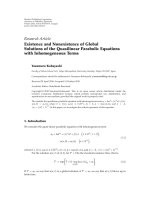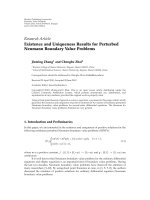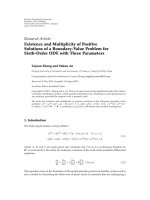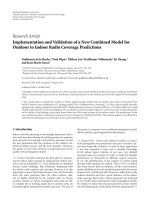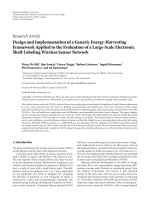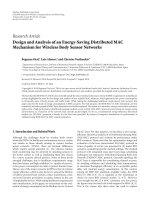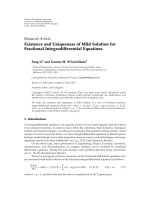Báo cáo hóa học: "Research Article Existence and Uniqueness of Smooth Positive Solutions to a Class of Singular m-Point Boundary Value Problems" potx
Bạn đang xem bản rút gọn của tài liệu. Xem và tải ngay bản đầy đủ của tài liệu tại đây (505.96 KB, 13 trang )
Hindawi Publishing Corporation
Boundary Value Problems
Volume 2009, Article ID 191627, 13 pages
doi:10.1155/2009/191627
Research Article
Existence and Uniqueness of
Smooth Positive Solutions to a Class of Singular
m-Point Boundary Value Problems
Xinsheng Du and Zengqin Zhao
School of Mathematics Sciences, Qufu Normal University, Qufu, Shandong 273165, China
Correspondence should be addressed to Xinsheng Du,
Received 2 April 2009; Revised 15 September 2009; Accepted 23 November 2009
Recommended by Donal O’Regan
This paper investigates the existence and uniqueness of smooth positive solutions to a class of
singular m-point boundary value problems of second-order ordinary differential equations. A
necessary and sufficient condition for the existence and uniqueness of smooth positive solutions is
given by constructing lower and upper solutions and with the maximal theorem. Our nonlinearity
ft, u,v may be singular at v, t 0 and/or t 1.
Copyright q 2009 X. Du and Z. Zhao. This is an open access article distributed under the Creative
Commons Attribution License, which permits unrestricted use, distribution, and reproduction in
any medium, provided the original work is properly cited.
1. Introduction and the Main Results
In this paper, we will consider the existence and uniqueness of positive solutions to a class
of second-order singular m-point boundary value problems of the following differential
equation:
−u
t
f
t, u
t
,u
t
,t∈
0, 1
, 1.1
with
u
0
m−2
i1
α
i
u
η
i
,u
1
0, 1.2
where 0 <α
i
< 1,i 1, 2, ,m− 2, 0 <η
1
<η
2
< ··· <η
m−2
< 1, are constants,
m−2
i1
α
i
<
1,m≥ 3, and f satisfies the following hypothesis:
2 Boundary Value Problems
H ft, u, v : 0, 1 × 0, ∞ × 0, ∞ → 0, ∞ is continuous, nondecreasing on u,
and nonincreasing on v for each fixed t ∈ 0, 1, there exists a real number b ∈ R
such that for any r ∈ 0, 1,
f
t, u, rv
≤ r
−b
f
t, u, v
, ∀
t, u, v
∈
0, 1
×
0, ∞
×
0, ∞
, 1.3
there exists a function g : 1, ∞ → 0, ∞,gl <l,andgl/l
2
is integrable on
1, ∞ such that
f
t, lu, v
≤ g
l
f
t, u, v
, ∀
t, u, v
∈
0, 1
×
0, ∞
×
0, ∞
,l∈
1, ∞
. 1.4
Remark 1.1. i Inequality 1.3 implies
f
t, u, cv
≥ c
−b
f
t, u, v
, if c ≥ 1. 1.5
Conversely, 1.5 implies 1.3.
ii Inequality 1.4 implies
f
t, cu, v
≥
g
c
−1
−1
f
t, u, v
, if 0 <c<1. 1.6
Conversely, 1.6 implies 1.4.
Remark 1.2. It follows from 1.3, 1.4 that
f
t, u, u
≤
⎧
⎪
⎪
⎨
⎪
⎪
⎩
g
u
v
f
t, v, v
, if u ≥ v>0,
v
u
b
f
t, v, v
, if v ≥ u>0.
1.7
When ft, u is increasing with respect to u, singular nonlinear m-point boundary
value problems have been extensively studied in the literature, see 1–3. However, when
ft, u, v is increasing on u, and is decreasing on v, the study on it has proceeded very slowly.
The purpose of this paper is to fill this gap. In addition, it is valuable to point out that the
nonlinearity ft, u, v may be singular at t 0,t 1and/orv 0.
When referring to singularity we mean that the functions f in 1.1 are allowed to be
unbounded at the points v 0,t 0, and/or t 1. A function ut ∈ C0, 1∩C
2
0, 1 is called
a C0, 1positive solution to 1.1 and 1.2 if it satisfies 1.1 and 1.2ut > 0, for t ∈
0, 1.AC0, 1positive solution to 1.1 and 1.2 is called a smooth positive solution if
u
0
and u
1
−
both exist ut > 0fort ∈ 0, 1. Sometimes, we also call a smooth solution
a C
1
0, 1 solution. It is worth stating here that a nontrivial C0, 1 nonnegative solution to
the problem 1.1, 1.2 must be a positive solution. In fact, it is a nontrivial concave function
satisfying 1.2 which, of course, cannot be equal to zero at any point t ∈ 0, 1.
To seek necessary and sufficient conditions for the existence of solutions to the above
problems is important and interesting, but difficult. Thus, researches in this respect are rare
Boundary Value Problems 3
up to now. In this paper, we will study the existence and uniqueness of smooth positive
solutions to the second-order singular m-point boundary value problem 1.1 and 1.2.A
necessary and sufficient condition for the existence of smooth positive solutions is given by
constructing lower and upper solutions and with the maximal principle. Also, the uniqueness
of the smooth positive solutions is studied.
A function αt is called a lower solution to the problem 1.1, 1.2,ifαt ∈ C0, 1 ∩
C
2
0, 1 and satisfies
α
t
f
t, α
t
,α
t
≥ 0,t∈
0, 1
,
α
0
−
m−2
i1
α
i
α
η
i
≤ 0,α
1
≤ 0.
1.8
Upper solution is defined by reversing the above inequality signs. If there exist a lower
solution αt and an upper solution βt to problem 1.1, 1.2 such that αt ≤ βt, t hen
αt,βt is called a couple of upper and lower solution to problem 1.1, 1.2.
To prove the main result, we need the following maximal principle.
Lemma 1.3 maximal principle. Suppose that 0 <η
1
<η
2
< ··· <η
m−2
<b
n
< 1,n 1, 2, ,
and F
n
{ut ∈ C0,b
n
∩ C
2
0,b
n
,u0 −
m−2
i1
α
i
uη
i
≥ 0,ub
n
≥ 0}.Ifu ∈ F
n
such that
−u
t ≥ 0,t∈ 0,b
n
then ut ≥ 0,t∈ 0,b
n
.
Proof. Let
−u
t
δ
t
,t∈
0,b
n
, 1.9
u
0
−
m−2
i1
α
i
u
η
i
r
1
,u
b
n
r
2
,
1.10
then r
1
≥ 0,r
2
≥ 0,δt ≥ 0,t∈ 0,b
n
.
By integrating 1.9 twice and noting 1.10, we have
u
t
1
b
n
1 −
m−2
i1
α
i
m−2
i1
α
i
η
i
1 −
m−2
i1
α
i
t
m−2
i1
α
i
η
i
r
2
b
n
− t
r
1
b
n
0
G
n
t, s
δ
s
ds
b
n
− t
b
n
1 −
m−2
i1
α
i
m−2
i1
α
i
η
i
m−2
i1
α
i
b
n
0
G
n
η
i
,s
δ
s
ds,
1.11
where
G
n
t, s
1
b
n
⎧
⎨
⎩
t
b
n
− s
, 0 ≤ t ≤ s ≤ b
n
,
s
b
n
− t
, 0 ≤ s ≤ t ≤ b
n
.
1.12
4 Boundary Value Problems
In view of 1.11 and the definition of G
n
t, s, we can obtain ut ≥ 0,t∈ 0,b
n
. This
completes the proof of Lemma 1.3.
Now we state the main results of this paper as follows.
Theorem 1.4. Suppose that H holds, then a necessary and sufficient condition for the problem 1.1
and 1.2 to have smooth positive solution is that
0 <
1
0
f
s, 1 − s, 1 − s
ds < ∞. 1.13
Theorem 1.5. Suppose that H and 1.13 hold, then the smooth positive solution to problem 1.1
and 1.2 is also the unique C0, 1 positive s olution.
2. Proof of Theorem 1.4
2.1. The Necessary Condition
Suppose that wt is a smooth positive solution to the boundary value problem 1.1 and
1.2. We will show that 1.13 holds.
It follows from
w
t
−f
t, w
t
,w
t
≤ 0,t∈
0, 1
, 2.1
that w
t is nonincreasing on 0, 1. Thus, by the Lebesgue theorem, we have
1
0
f
t, w
t
,w
t
dt −
1
0
w
t
dt w
0
− w
1−
< ∞. 2.2
It is well known that wt can be stated as
w
t
1
0
G
t, s
f
s, w
s
,w
s
ds
1 − t
1 −
m−2
i1
α
i
m−2
i1
α
i
η
i
m−2
i1
α
i
1
0
G
η
i
,s
f
s, w
s
,w
s
ds,
2.3
where
G
t, s
⎧
⎨
⎩
t
1 − s
, 0 ≤ t ≤ s ≤ 1,
s
1 − t
, 0 ≤ s ≤ t ≤ 1.
2.4
Boundary Value Problems 5
By 2.3 and 1.2 we have
1
1 −
m−2
i1
α
i
m−2
i1
α
i
η
i
m−2
i1
α
i
1
0
G
η
i
,s
f
s, w
s
,w
s
ds
m−2
i1
α
i
w
η
i
, 2.5
therefore because of 2.3 and 2.5,
w
t
≥
1 − t
m−2
i1
α
i
w
η
i
,t∈
0, 1
. 2.6
Since wt is a smooth positive solution to 1.1 and 1.2, we have
w
t
1
t
−w
s
ds ≤ max
t∈
0,1
w
t
1 − t
,t∈
0, 1
. 2.7
Let m
m−2
i1
α
i
wη
i
,M max
t∈0,1
|w
t|. From 2.6, 2.7 it follows that
m
1 − t
≤ w
t
≤ M
1 − t
,t∈
0, 1
. 2.8
Without loss of generality we may assume that 0 <m<1 <M.This together with the
condition H implies
1
0
f
s, 1 − s, 1 − s
ds ≤
1
0
f
s,
1
m
w
s
,
1
M
w
s
ds
≤ g
1
m
M
b
1
0
f
s, w
s
,w
s
ds < ∞.
2.9
On the other hand, notice that wt is a smooth positive solution to 1.1, 1.2,we
have
f
t, w
t
,w
t
−w
t
/
≡ 0,t∈
0, 1
, 2.10
therefore, there exists a positive number t
0
∈ 0, 1 such that ft
0
,wt
0
,wt
0
> 0. Obviously,
wt
0
> 0and1− t
0
> 0. It follows from 1.7 that
0 <f
t
0
,w
t
0
,w
t
0
≤
⎧
⎪
⎪
⎪
⎨
⎪
⎪
⎪
⎩
g
w
t
0
1 − t
0
f
t
0
, 1 − t
0
, 1 − t
0
, if w
t
0
≥ 1 − t
0
,
1 − t
0
w
t
0
b
f
t
0
, 1 − t
0
, 1 − t
0
, if w
t
0
≤ 1 − t
0
.
2.11
6 Boundary Value Problems
Consequently ft
0
, 1 − t
0
, 1 − t
0
> 0, which implies that
1
0
f
s, 1 − s, 1 − s
ds > 0. 2.12
From 2.9 and 2.12 it follows that
0 <
1
0
f
s, 1 − s, 1 − s
< ∞, 2.13
which is the required inequality.
2.2. The Existence of Lower and Upper Solutions
Since gl/l
2
is integrable on 1, ∞, thus
lim
l → ∞
inf
g
l
l
0. 2.14
Otherwise, if lim
l → ∞
inf gl/l m
0
> 0, then there exists a real number X>0, such that
gl/l
2
≥ m
0
/2l when l>X,this contradicts with the condition that gl/l
2
is integrable on
1, ∞. By condition H and 2.14 we have
f
t, ru, v
≥ h
r
f
t, u, v
,r∈
0, 1
, 2.15
lim
r → 0
sup
r
h
r
lim
p → ∞
sup
p
−1
h
p
−1
lim
p → ∞
inf
g
p
p
0, 2.16
where hrgr
−1
−1
,r∈ 0, 1.
Suppose that 1.13 holds. Let
b
t
1
0
G
t, s
f
s, 1 − s, 1 − s
ds
1 − t
1 −
m−2
i1
α
i
m−2
i1
α
i
η
i
m−2
i1
α
i
1
0
G
η
i
,s
f
s, 1 − s, 1 − s
ds.
2.17
Since by 1.13, 2.17 we obviously have
b
t
∈ C
1
0, 1
∩ C
2
0, 1
,b
t
−f
t, 1 − t, 1 − t
,t∈
0, 1
, 2.18
and there exists a positive number k<1 such that
k
1 − t
≤ b
t
≤
1
k
1 − t
,t∈
0, 1
. 2.19
Boundary Value Problems 7
By 2.14 and 2.16 we see, if 0 <l<kis sufficiently small, then
h
lk
− l ≥ 0,g
1
lk
−
1
l
≤ 0. 2.20
Let
H
t
lb
t
,Q
t
1
l
b
t
,t∈
0, 1
. 2.21
Then from 2.19 and 2.21 we have
lk
1 − t
≤ H
t
≤ 1 − t ≤ Q
t
≤
1
lk
1 − t
,t∈
0, 1
. 2.22
Consequently, with the aid of 2.20, 2.22 and the condition H we have
H
t
f
t, H
t
,H
t
≥ f
t, lk
1 − t
, 1 − t
− lf
t, 1 − t, 1 − t
≥
h
lk
− l
f
t, 1 − t, 1 − t
≥ 0,
2.23
Q
t
f
t, Q
t
,Q
t
≤ f
t,
1
lk
1 − t
, 1 − t
−
1
l
f
t, 1 − t, 1 − t
≤
g
1
lk
−
1
l
f
t, 1 − t, 1 − t
≤ 0.
2.24
From 2.17, 2.21 it follows that
H
0
m−2
i1
α
i
H
η
i
,H
1
0,
2.25
Q
0
m−2
i1
α
i
Q
η
i
,Q
1
0,
2.26
therefore, 2.23–2.26 imply that Ht,Qt are lower and upper solutions to the problem
1.1 and 1.2, respectively.
2.3. The Sufficient Condition
First of all, we define a partial ordering in C0, 1 ∩ C
2
0, 1 by u ≤ v, if and only if
u
t
≤ v
t
, ∀t ∈
0, 1
. 2.27
8 Boundary Value Problems
Then, we will define an auxiliary function. For all ut ∈ C0, 1 ∩ C
2
0, 1,
g
t, u
t
⎧
⎪
⎪
⎪
⎨
⎪
⎪
⎪
⎩
f
t, H
t
,H
t
, if u
t
≤ H
t
,
f
t, u
t
,u
t
, if H
t
≤ u
t
≤ Q
t
,
f
t, Q
t
,Q
t
, if u
t
≥ Q
t
.
2.28
By the assumption of Theorem 1.4, we have that g :
0, 1 × −∞, ∞ → 0, ∞ is
continuous.
Let {b
n
} be a sequence satisfying η
m−2
<b
1
< ··· <b
n
<b
n1
< ··· < 1, and b
n
→ 1as
n → ∞, and let {r
n
} be a sequence satisfying
H
b
n
≤ r
n
≤ Q
b
n
,n 1, 2, 2.29
For each n, let us consider the following nonsingular problem:
−u
t
g
t, u
t
,t∈
0,b
n
,
u
0
−
m−2
i1
α
i
u
η
i
0,u
b
n
r
n
.
2.30
Obviously, it follows from the proof of Lemma 1.3 that problem 2.30 is equivalent to the
integral equation
u
t
A
n
u
t
1 −
m−2
i1
α
i
t
m−2
i1
α
i
η
i
r
n
b
n
1 −
m−2
i1
α
i
m−2
i1
α
i
η
i
b
n
0
G
n
t, s
g
s, u
s
ds
b
n
− t
b
n
1 −
m−2
i1
α
i
m−2
i1
α
i
η
i
m−2
i1
α
i
b
n
0
G
n
η
i
,s
g
s, u
s
ds, t ∈
0,b
n
,
2.31
where G
n
t, s is defined in the proof of Lemma 1.3. It is easy to verify that A
n
: X
n
→
X
n
C0,b
n
is a completely continuous operator and A
n
X
n
is a bounded set. Moreover,
u ∈ C0,b
n
is a solution to 2.30 if and only if A
n
u u. Using the Schauder’s fixed point
theorem, we assert that A
n
has at least one fixed point u
n
∈ C
2
0,b
n
.
We claim that
H
t
≤ u
n
t
≤ Q
t
,t∈
0,b
n
. 2.32
From this it follows that
−u
t
f
t, u
t
,u
t
,t∈
0,b
n
. 2.33
Boundary Value Problems 9
Suppose by contradiction that u
n
t ≤ Qt is not satisfied on 0,b
n
.Let
z
t
Q
t
− u
n
t
,t∈
0,b
n
, 2.34
therefore
z
t
∗
min
t∈
0,b
n
z
t
< 0. 2.35
Since by the definition of Qt and 2.30 we obviously have t
∗
/
0,t
∗
/
b
n
.
Let
c inf
{
t
1
| z
t
< 0,t∈
t
1
,t
∗
}
,
d sup
{
t
2
| z
t
< 0,t∈
t
∗
,t
2
}
.
2.36
So, when t ∈ c, d, we have Qt <u
n
t, and
g
t, u
n
t
f
t, Q
t
,Q
t
,
u
n
t
g
t, Q
t
0,
Q
t
g
t, Q
t
Q
t
f
t, Q
t
,Q
t
≤ 0.
2.37
Therefore z
tQ
t−u
n
t ≤ 0,t∈ c, d, that is, zt is an upper convex function in c, d.
By 2.30 and 2.36,forc, d we have the following two cases:
i zczd0,
ii zc < 0,zd0.
For case i: it is clear that zt ≥ 0,t∈ c, d, this is a contradiction.
For case ii: in this case c 0,z
t
∗
0. Since z
t is decreasing on c, d,thus,
z
t ≤ 0,t∈ t
∗
,d, that is, zt is decreasing on t
∗
,d. From zd0, we see zt
∗
≥ 0,
which is in contradiction with zt
∗
< 0.
From this it follows that u
n
t ≤ Qt,t∈ 0,b
n
.
Similarly, we can verify that Ht ≤ u
n
t,t∈ 0,b
n
. Consequently 2.32 holds.
Using the method of 4 and 5 , Theorem 3.2, we can obtain that there is a C0, 1
positive solution wt to 1.1, 1.2 such that Ht ≤ wt ≤ Qt, and a subsequence of
{u
n
t} converges to wt on any compact subintervals of 0, 1.
10 Boundary Value Problems
3. Proof of Theorem 1.5
Suppose that u
1
t and u
2
t are C0, 1 positive solutions to 1.1 and 1.2, and at least one of
them is a smooth positive solution. If u
1
t
/
≡ u
2
t for any t ∈ 0, 1, without loss of generality,
we may assume that u
2
t
∗
>u
1
t
∗
for some t
∗
∈ 0, 1. Let
T inf
{
t
1
| 0 ≤ t
1
<t
∗
,u
2
t
>u
1
t
,t∈
t
1
,t
∗
}
,
S sup
{
t
2
| t
∗
≤ t
2
< 1,u
2
t
>u
1
t
,t∈
t
∗
,t
2
}
,
y
t
u
1
t
u
2
t
− u
2
t
u
1
t
,t∈
0, 1
.
3.1
It follows from 3.1 that
0 ≤ T<S≤ 1,u
2
t
≥ u
1
t
,t∈
T, S
. 3.2
By 1.2, it is easy to check that there exist the following two possible cases:
1 u
1
Tu
2
T,u
1
Su
2
S,
2 u
1
T <u
2
T,u
1
Su
2
S.
Assume that case 1 holds. By u
i
t ≤ 0on0, 1, it is easy to see t hat u
i
T 0i 1, 2
exist finite or ∞, moreover, one of them must be finite. The same conclusion is also valid for
u
i
S − 0i 1, 2. It follows from 3.2 that
u
2
t
− u
1
t
|
tT0
≥ 0, 3.3
consequently
u
2
T 0
≥ u
1
T 0
,u
1
T 0
is finite. 3.4
Similarly
u
2
S − 0
≤ u
1
S − 0
,u
1
S − 0
is finite. 3.5
From 3.1, 3.4,and3.5 we have
lim inf
t−→ T0
y
t
≥ 0 ≥ lim sup
t−→ S−0
y
t
. 3.6
On the other hand, 3.2, 1.7, and condition H yield
f
t, u
2
t
,u
2
t
≤ g
u
2
t
u
1
t
f
t, u
1
t
,u
1
t
≤
u
2
t
u
1
t
f
t, u
1
t
,u
1
t
,t∈
T, S
,
3.7
Boundary Value Problems 11
that is,
f
t, u
2
t
,u
2
t
u
2
t
≤
f
t, u
1
t
,u
1
t
u
1
t
,t∈
T, S
, 3.8
therefore
u
1
t
u
1
t
≤
u
2
t
u
2
t
,t∈
T, S
. 3.9
From this it follows that
y
t
u
1
t
u
2
t
− u
2
t
u
1
t
≥ 0,t∈
T, S
. 3.10
If y
t ≡ 0onT, S, then, by 3.6 we have yt ≡ 0, and then u
2
t/u
1
t
≡ 0,
which imply that there exists a positive number c such that u
2
tcu
1
t on T, S. It follows
from 3.2 that c>1, therefore T 0,S 1. Substituting u
2
tcu
1
t into 1.1 and using
condition H, we have
cf
t, u
1
t
,u
1
t
f
t, cu
1
t
,cu
1
t
≤ g
c
f
t, u
1
t
,u
1
t
,t∈
0, 1
.
3.11
Noticing 3.11 and ft, u
1
t,u
1
t
/
≡ 0,t∈ 0, 1, we have
c ≤ g
c
, 3.12
which contradicts with the condition that gc <c.Therefore, y
t ≥ 0andy
t
/
≡ 0onT, S.
Thus, yT 0 <yS − 0, which contradicts with 3.6. So case 1 is impossible.
By analogous methods, we can obtain a contradiction for case 2.Sou
1
t ≡ u
2
t for
any t ∈ 0, 1, which implies that the result of Theorem 1.5 holds.
4. Concerned Remarks and Applications
Remark 4.1. The typical function satisfying H is ft, u, u
n
i1
a
i
tu
λ
i
m
j1
b
j
tu
−μ
j
,
where a
i
,b
j
∈ C0, 1, 0 <λ
i
< 1,μ
j
> 0, i 1, 2, ,n, j 1, 2, ,m.
Remark 4.2. Condition H includes e-concave function see 6 as special case. For example,
Liu and Yu 7 consider the existence and uniqueness of positive solution to a class of singular
boundary value problem under the following condition:
f
t, λu,
v
λ
≥ λ
α
f
t, u, v
, ∀u, v > 0,λ∈
0, 1
, 4.1
where α ∈ 0, 1 and ft, u, v is nondecreasing on u, nonincreasing on v. Clearly, condition
H is weaker than the above condition 4.1.
12 Boundary Value Problems
In fact, for any λ ≥ 1, from 4.1 it follows that
f
t, λu, v
≤ f
t, λu,
1
λ
v
≤ λ
α
f
t, u, v
. 4.2
On the other hand, for any 0 <λ<1, from 4.1 it follows that
f
t, u, v
≥ f
t, λu, λ
v
λ
≥ λ
α
f
t, u, λv
, 4.3
that is, ft, u, λv ≤ λ
−α
ft, u, v.
In what follows, by using the results obtained in this paper, we study the boundary
value problem
u
t
μt
−γ
1 − t
−l
u
−α
t
u
β
t
A
0, 0 <t<1,
u
0
m−2
i1
α
i
u
η
i
,u
1
0,
4.4
where μ>0,α>0,β<1,A≥ 0. We have the following theorem.
Theorem 4.3. A necessary and sufficient condition for problem 4.4 to have smooth positive solution
is that
max
γ α, l α, γ − β, l − β, γ, l
< 1. 4.5
Moreover, when the positive solution exists, it is unique.
Remark 4.4. Consider 1.1 and the following singular m-point boundary value conditions:
u
0
0,u
1
m−2
i1
α
i
u
η
i
. 4.6
By analogous methods, we have the following results.
Assume that ut is a C0, 1 positive solution to 1.1 and 4.6, then ut can be stated
u
t
1
0
G
t, s
f
s, u
s
,u
s
t
1 −
m−2
i1
α
i
η
i
m−2
i1
α
i
1
0
G
η
i
,s
f
s, u
s
,u
s
ds, 4.7
where Gt, s is defined in 2.4.
Theorem 4.5. Suppose that H holds, then a necessary and sufficient condition for the problem 1.1
and 4.6 to have smooth positive solution is that
0 <
1
0
f
s, s, s
ds < ∞. 4.8
Boundary Value Problems 13
Theorem 4.6. Suppose H and 4.8 hold, then the smooth positive solution to problem 1.1 and
4.6 is also unique C0, 1 positive solution.
Acknowledgment
Research supported by the National Natural Science Foundation of China 10871116,the
Natural Science Foundation of Shandong Province Q2008A03 and the Doctoral Program
Foundation of Education Ministry of China 200804460001.
References
1 X. Du and Z. Zhao, “A necessary and sufficient condition of the existence of positive solutions to
singular sublinear three-point boundary value problems,” Applied Mathematics and Computation, vol.
186, no. 1, pp. 404–413, 2007.
2 X. Du and Z. Zhao, “On existence theorems of positive solutions to nonlinear singular differential
equations,” Applied Mathematics and Computation, vol. 190, no. 1, pp. 542–552, 2007.
3 Z. Wei, “A necessary and sufficient condition for the existence of positive solutions of singular super-
linear m-point boundary value problems,” Applied Mathematics and Computation, vol. 179, no. 1, pp.
67–78, 2006.
4 Y. Zhang, “Positive solutions of singular sublinear Emden-Fowler boundary value problems,” Journal
of Mathematical Analysis and Applications, vol. 185, no. 1, pp. 215–222, 1994.
5 P. Hartman, Ordinary Differential Equations,Brikh
¨
auser, Boston, Mass, USA, 2nd edition, 1982.
6 D. J. Guo and V. Lakshmikantham, Nonlinear Problems in Abstract Cones, vol. 5 of Notes and Reports in
Mathematics in Science and Engineering, Academic Press, Boston, Mass, USA, 1988.
7 Y. Liu and H. Yu, “Existence and uniqueness of positive solution for singular boundary value
problem,” Computers & Mathematics with Applications, vol. 50, no. 1-2, pp. 133–143, 2005.



